Vietnamese New Year is the most beloved traditional holiday in Vietnam, celebrated according to the lunar calendar. This lively and meaningful festival welcomes the arrival of spring and symbolizes a fresh start filled with hope, faith, and gratitude. Join Sanhotelseries to explore how Vietnamese New Year is celebrated according to the lunar calendar and uncover the traditions that make it truly special!
When does Tet take place?
Tet takes place at a different time each year depending on the time of the first new moon according to the lunar calendar. However, it is usually in mid-January and late February. Below is a table of years corresponding to the first day of Vietnamese Lunar New Year:*/3+2
| Zodiac Sign | Vietnamese Name | Years | New Year Date (Upcoming) |
| Cat | Mão | 2023, 2035, 2047, 2059, 2071 | January 22 |
| Dragon | Thìn | 2024, 2036, 2048, 2060, 2072 | February 10 |
| Snake | Tỵ | 2025, 2037, 2049, 2061, 2073 | January 29 |
| Horse | Ngọ | 2026, 2038, 2050, 2062, 2074 | February 17 |
| Goat | Mùi | 2027, 2039, 2051, 2063, 2075 | February 6 |
| Monkey | Thân | 2028, 2040, 2052, 2064, 2076 | January 26 |
| Rooster | Dậu | 2029, 2041, 2053, 2065, 2077 | February 13 |
| Dog | Tuất | 2030, 2042, 2054, 2066, 2078 | February 3 |
| Pig | Hợi | 2031, 2043, 2055, 2067, 2079 | January 23 |
| Rat | Tý | 2032, 2044, 2056, 2068, 2080 | February 11 |
| Buffalo | Sửu | 2021, 2033, 2045, 2057, 2069 | January 31 |
| Tiger | Dần | 2022, 2034, 2046, 2058, 2070 | February 19 |
Vietnamese Lunar New Year can sometimes be celebrated on a different day than other countries that also celebrate Lunar New Year. This is because of the different time zones, Lunar New Year is celebrated exactly on the new moon day.
Vietnamese New Year is celebrated according to the lunar calendar (Tết Nguyên Đán)
Tet, also known as the Vietnamese Lunar New Year, is the most significant traditional holiday of the year for the Vietnamese people. It is a time when everyone pauses their busy lives to reunite with family and loved ones. For every Vietnamese person, Tet holds deep meaning as a celebration of togetherness and a symbol of new hope for the year ahead.
This festive season typically begins on the 23rd day of the twelfth lunar month and lasts until the 7th day of the first lunar month. It is a cherished occasion filled with customs and traditions that have been preserved for generations.
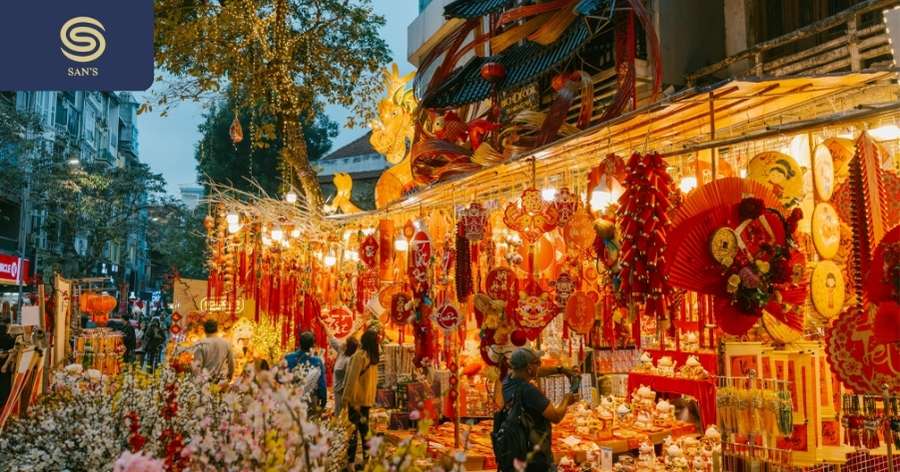
Key customs during Tet include honoring the Kitchen Gods on the 23rd day of the twelfth lunar month, making square sticky rice cakes, decorating homes with flowers, preparing the five-fruit tray, and performing year-end offerings. Other cherished practices are the New Year’s Eve ritual, welcoming the first visitor of the year, setting off on lucky journeys, exchanging New Year greetings, giving lucky money to children and elders, picking the first spring buds, visiting ancestors’ graves, and praying at temples for blessings in the new year.
Traditional dishes play an essential role in Tet celebrations, offering a taste of cultural heritage. These include square sticky rice cakes, cylindrical sticky rice cakes, boiled chicken, Vietnamese sausage, pickled shallots, sticky rice, jellied pork, spring rolls, bamboo shoot soup, winter melon soup with stuffed bitter gourd, and other delightful creations.
Why is Tet so important to Vietnamese people?
Although there are similarities between the Vietnamese Lunar New Year, known as Tet, and the Chinese Lunar New Year, each country has developed its own unique way of celebrating this important occasion. Lunar New Year is also celebrated in many Asian countries, including Singapore, Malaysia, and South Korea, each with distinct customs and practices
Tet is the most important holiday in Vietnam’s calendar. Officially lasting three days, many families extend the celebrations to an entire week. Its importance is akin to the combined festive spirit of Christmas and New Year in the United Kingdom. During this period, families reunite, share meals, and reconnect with friends.
Businesses often close for Tet, and companies give employees time off to spend with their loved ones. For those required to work during this festive period, wages are typically tripled as a gesture of appreciation.
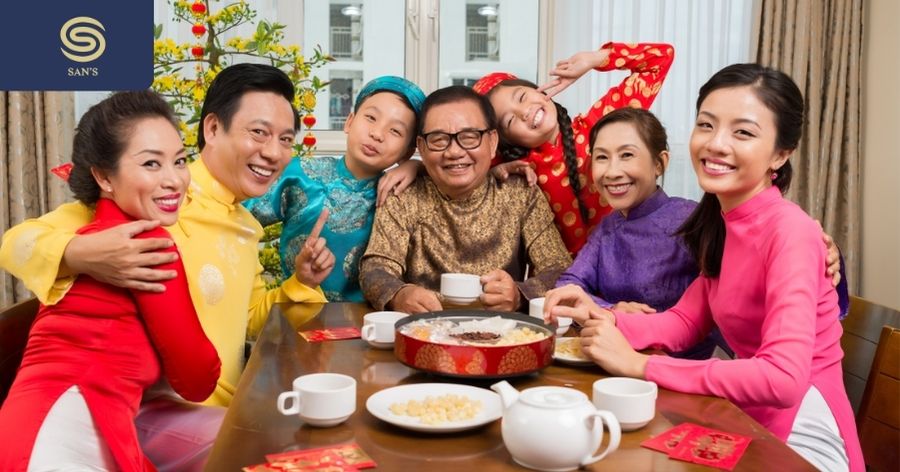
In Vietnamese culture, the word “Tet” signifies “festival,” and while other holidays like the Mid-Autumn Festival (Tet Trung Thu) also bear this prefix, the New Year celebration is so significant that it is simply referred to as Tet. The Mid-Autumn Festival, also called the Children’s Festival, is the second most important occasion, but if you mention Tet, everyone will know you are referring to the Lunar New Year.
Tet holds profound psychological and cultural significance. Beyond being a time for reunions, it is an opportunity to express gratitude to higher deities, fostering harmony with the divine forces of Heaven (Thien) and Earth (Dia). This spiritual connection underpins the essence of Tet, making it not only a celebration of the new year but also a time to honor the balance between nature, humanity, and the heavens.
Unique customs of Vietnamese New Year
The Vietnamese Lunar New Year, or Tet, is a vibrant traditional celebration that honors family, culture, and hopes for a prosperous and peaceful new year. The following customs lie at the heart of Tet, reflecting the richness of Vietnam’s cultural identity.
Kitchen God day (“Ông Công” and “Ông Táo”)
An integral part of Vietnamese culture, Kitchen God Day is celebrated on the 23rd day of the 12th lunar month each year. According to tradition, Ong Cong and Ong Tao are the gods who oversee every family’s affairs. On this day, they return to heaven to present an annual report on the household’s activities to the Jade Emperor.
To honor these deities, families clean their altars, prepare fresh offerings of fruits, delicacies, flowers, and symbolic paper garments, burn incense, and release a live carp into a river or pond. The carp acts as a vehicle to carry the gods on their journey to heaven.
Cleaning and decorating the house
For Vietnamese families, cleaning the house at year’s end symbolizes sweeping away the misfortunes of the old year, while decorating the home invites luck, joy, and prosperity in the year ahead.
Kumquat trees, peach blossoms, and apricot blossoms are quintessential symbols of Tet. Every household selects at least one of these plants to adorn their living space or garden, signaling the arrival of the festive season. Additionally, fresh flowers in elegant vases add a touch of refinement and vitality to the home.
Wrapping Chung cake (bánh Chưng) and Tet cake (bánh Tét)
Chung Cake in the North and Tet Cake in the South are iconic dishes of the Vietnamese New Year. In the days leading up to Tet, families gather to prepare and wrap these cakes together. These symbolic offerings are placed on the ancestral altar and shared during festive meals to celebrate the arrival of the new year.
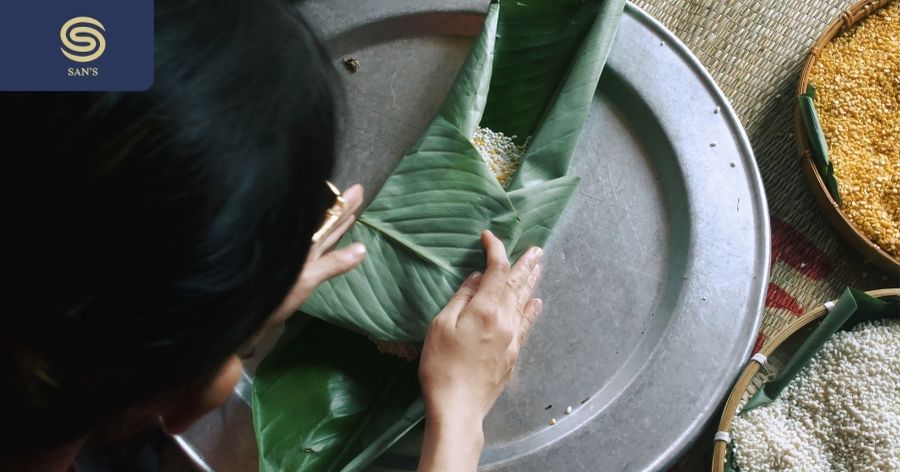
Preparing the five-fruit tray (Mâm Ngũ Quả)
The five-fruit tray is a central feature on the ancestral altar during Tet. It represents respect for ancestors and prayers for blessings, health, happiness, and prosperity in the new year. Families carefully choose five different fruits, reflecting regional traditions, and arrange them artistically to create a meaningful and beautiful display.
Visiting ancestors’ graves
A day before Tet, families gather to visit their ancestors’ graves. Together, they clean the site, make offerings, and burn incense as a heartfelt tribute to past generations. This custom exemplifies the deep respect and gratitude Vietnamese people hold for their forebears, creating a profound sense of connection between the past and the present.
The days of Tet: A journey through tradition
Here are the things Vietnamese people usually do from the last day of the old year until the end of Tet.
Families gather for a year-end meal (Cơm Tất Niên)
The year-end offering, an essential tradition of Vietnamese Lunar New Year, takes place on the 29th or 30th day of the last lunar month, often coinciding with New Year’s Eve. This sacred ceremony involves preparing a feast of savory dishes and fruits to honor ancestors and deities while bidding farewell to the old year. Families use this moment to express gratitude and pray for a prosperous and peaceful new year.
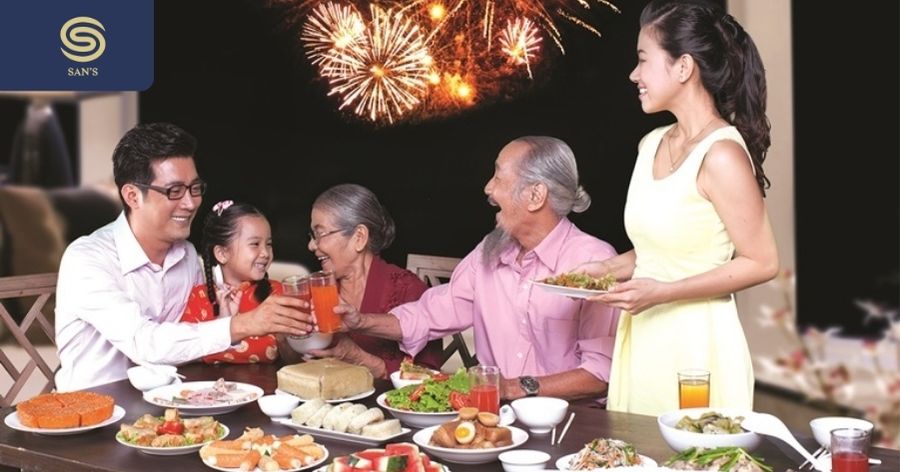
Welcoming the New Year with fireworks
As the clock strikes midnight, fireworks light up the sky, symbolizing hope and joy for the year ahead. Many people gather at designated locations to enjoy these spectacular displays, creating a vibrant atmosphere that marks the start of Tet.
The first day of Tet
The first day of Tet is a very important day. On this day, people often go to wish the elderly and children a happy new year, giving lucky money. This is the time when children wear new clothes and send New Year wishes to the elderly in exchange for red envelopes containing money as a symbol of good luck.
The act of the first visitor entering a house on New Year’s Day, called “xông đất” or “xông nhà,” holds significant meaning in Vietnamese culture. Families carefully select a person of good character, moral integrity, and success to bring fortune and blessings for the entire year. Uninvited visits on this day are avoided, as the first guest is believed to set the tone for the family’s luck throughout the year.
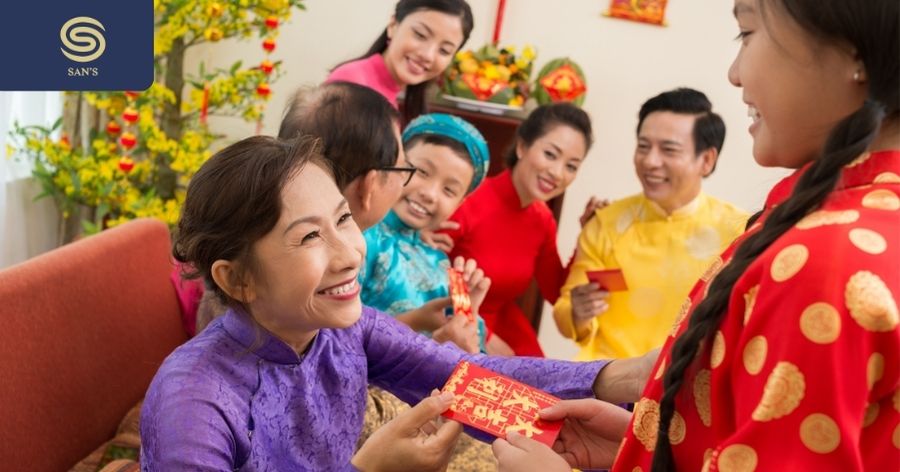
Spreading joy in the days that follow
In the subsequent days of Tet, families visit relatives and friends to share festive cheer. Traditionally, the second day is reserved for friends, while the third day honors teachers and other respected individuals in Vietnamese society.
Local Buddhist temples become popular destinations during Tet, as people make donations, seek blessings, and consult fortune-tellers to gain insights into the year ahead. These activities reflect a deep sense of spirituality and hope that defines this special time of year.
>> Read more: What Vietnamese people do on first day of the Lunar New Year?
Things to avoid during Tet and tips to attract good fortune
Avoid sweeping or taking out trash on the first day of Tet
According to traditional Vietnamese beliefs, sweeping the house or taking out the trash on the first day of Tet is akin to sweeping away luck and wealth for the new year. It is also believed that disposing of trash drives away the Kitchen Gods, taking prosperity with them. Instead, families gather the trash in a corner and wait until the second day of Tet to clean it out.
Breaking objects
Breaking household items such as mirrors, bowls, or plates during Tet is considered a bad omen. According to Vietnamese traditions, this symbolizes potential discord, loss of relationships, or financial instability in the year ahead. To ensure a smooth and auspicious new year, families take extra care to avoid breakage during this time.
Borrowing or lending money at the start of the year
The act of borrowing or lending money during Tet is widely avoided. Traditional beliefs hold that lending money may disperse your wealth, while borrowing money signifies financial struggles throughout the year. To maintain prosperity and financial stability, people refrain from such transactions at the beginning of the year.
Avoiding negative words
It is believed that words spoken at the start of the year can influence events in the months to come. Therefore, people avoid saying anything negative, unlucky, or profane, even in jest. Words like “death,” “failure,” or “poverty” are avoided, while positive wishes and cheerful greetings are encouraged to set a hopeful tone for the new year.
Avoid giving away fire or water
In Vietnamese culture, fire symbolizes luck and warmth, while water represents the flow of wealth. Giving away fire or water at the start of the year is believed to diminish one’s good fortune. Families ensure that these elements remain within their homes to attract prosperity and happiness.
Avoid certain foods
Some foods are considered unlucky to consume during Tet. Eating dog meat, squid, or duck on the first day is avoided, as they are associated with bad luck. Squid’s black ink is seen as a symbol of misfortune, while the phrase “clumsy as a duck” is believed to represent struggles and instability.
Ways to enhance luck and prosperity during Tet
Buying salt
Purchasing salt at the start of the year is thought to ward off negative energy and bring harmony to the household. The salt’s strong, savory taste symbolizes lasting relationships and unity among family and friends.

Visiting temples
Visiting a temple during Tet is not only a spiritual act but also a cherished cultural tradition. People pray for health, happiness, and prosperity while finding a moment of peace and reflection after a busy year.
Picking spring buds
Picking small branches or buds at the start of spring is a symbolic act to attract good fortune and fresh beginnings. These buds represent growth, hope, and success in the new year, making it a beloved tradition during Tet.
=>See more: Celebrating Lunar New Year 2025: Traditions, Customs, and Joy in Vietnam
Here is the “Vietnamese New Year is celebrated according to the lunar calendar”. Wishing you a delightful trip to Vietnam! If you’re visiting Vietnam and the capital, Hanoi, you can book a room at San Hotel at the best prices here!





